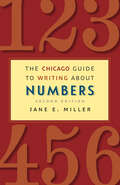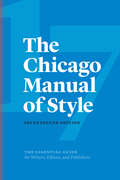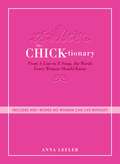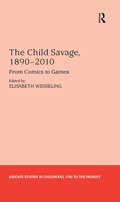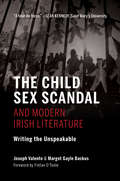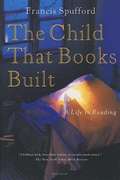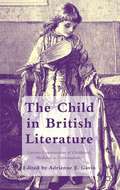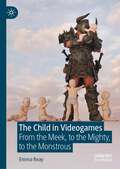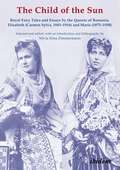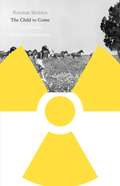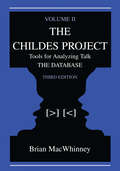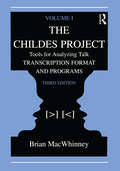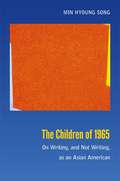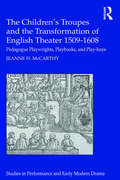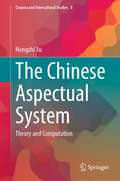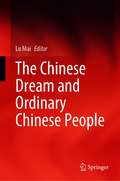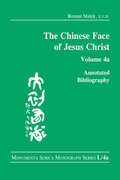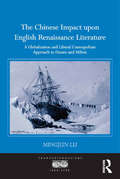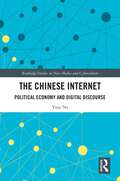- Table View
- List View
The Chicago Guide to Writing about Numbers; Second Edition (Chicago Guides to Writing, Editing, and Publishing)
by Jane E. MillerEarning praise from scientists, journalists, faculty, and students, The Chicago Guide to Writing about Numbers has helped thousands of writers communicate data clearly and effectively. Its publication offered a much-needed bridge between good quantitative analysis and clear expository writing, using straightforward principles and efficient prose. With this new edition, Jane Miller draws on a decade of additional experience and research, expanding her advice on reaching everyday audiences and further integrating non-print formats. Miller, an experienced teacher of research methods, statistics, and research writing, opens by introducing a set of basic principles for writing about numbers, then presents a toolkit of techniques that can be applied to prose, tables, charts, and presentations. Throughout the book, she emphasizes flexibility, showing writers that different approaches work for different kinds of data and different types of audiences. The second edition adds a chapter on writing about numbers for lay audiences, explaining how to avoid overwhelming readers with jargon and technical issues. Also new is an appendix comparing the contents and formats of speeches, research posters, and papers, to teach writers how to create all three types of communication without starting each from scratch. An expanded companion website includes new multimedia resources such as slide shows and podcasts that illustrate the concepts and techniques, along with an updated study guide of problem sets and suggested course extensions. This continues to be the only book that brings together all the tasks that go into writing about numbers, integrating advice on finding data, calculating statistics, organizing ideas, designing tables and charts, and writing prose all in one volume. Field-tested with students and professionals alike, this holistic book is the go-to guide for everyone who writes or speaks about numbers.
The Chicago Manual of Style
by The University The University of Chicago Press Editorial StaffTechnologies may change, but the need for clear and accurate communication never goes out of style. That is why for more than one hundred years The Chicago Manual of Style has remained the definitive guide for anyone who works with words. <p><p> In the seven years since the previous edition debuted, we have seen an extraordinary evolution in the way we create and share knowledge. This seventeenth edition of The Chicago Manual of Style has been prepared with an eye toward how we find, create, and cite information that readers are as likely to access from their pockets as from a bookshelf. It offers updated guidelines on electronic workflows and publication formats, tools for PDF annotation and citation management, web accessibility standards, and effective use of metadata, abstracts, and keywords. It recognizes the needs of those who are self-publishing or following open access or Creative Commons publishing models. The citation chapters reflect the ever-expanding universe of electronic sources—including social media posts and comments, private messages, and app content—and also offer updated guidelines on such issues as DOIs, time stamps, and e-book locators. <p><p> Other improvements are independent of technological change. The chapter on grammar and usage includes an expanded glossary of problematic words and phrases and a new section on syntax as well as updated guidance on gender-neutral pronouns and bias-free language. Key sections on punctuation and basic citation style have been reorganized and clarified. To facilitate navigation, headings and paragraph titles have been revised and clarified throughout. And the bibliography has been updated and expanded to include the latest and best resources available. <p><p> This edition continues to reflect expert insights gathered from Chicago’s own staff and from an advisory board of publishing experts from across the profession. It also includes suggestions inspired by emails, calls, and even tweets from readers. No matter how much the means of communication change, The Chicago Manual of Style remains the ultimate resource for those who care about getting the details right.
The Chicago Manual of Style (15th Edition)
by University of Chicago PressIn the 1890s, a proofreader at the University of Chicago Press prepared a single sheet of typographic fundamentals intended as a guide for the University community. That sheet grew into a pamphlet, and the pamphlet grew into a book--the first edition of the Manual of Style, published in 1906. Now in its fifteenth edition,The Chicago Manual of Style--the essential reference for authors, editors, proofreaders, indexers, copywriters, designers, and publishers in any field--is more comprehensive and easier to use than ever before. Those who work with words know how dramatically publishing has changed in the past decade, with technology now informing and influencing every stage of the writing and publishing process. In creating the fifteenth edition of the Manual, Chicago's renowned editorial staff drew on direct experience of these changes, as well as on the recommendations of the Manual's first advisory board, composed of a distinguished group of scholars, authors, and professionals from a wide range of publishing and business environments. Every aspect of coverage has been examined and brought up to date--from publishing formats to editorial style and method, from documentation of electronic sources to book design and production, and everything in between. In addition to books, the Manual now also treats journals and electronic publications. All chapters are written for the electronic age, with advice on how to prepare and edit manuscripts online, handle copyright and permissions issues raised by technology, use new methods of preparing mathematical copy, and cite electronic and online sources. A new chapter covers American English grammar and usage, outlining the grammatical structure of English, showing how to put words and phrases together to achieve clarity, and identifying common errors. The two chapters on documentation have been reorganized and updated: the first now describes the two main systems preferred by Chicago, and the second discusses specific elements and subject matter, with examples of both systems. Coverage of design and manufacturing has been streamlined to reflect what writers and editors need to know about current procedures. And, to make it easier to search for information, each numbered paragraph throughout the Manual is now introduced by a descriptive heading. Clear, concise, and replete with commonsense advice,The Chicago Manual of Style, fifteenth edition, offers the wisdom of a hundred years of editorial practice while including a wealth of new topics and updated perspectives. For anyone who works with words, whether on a page or computer screen, this continues to be the one reference book you simply must have. What's new in the Fifteenth Edition: * Updated material throughout to reflect current style, technology, and professional practice * Scope expanded to include journals and electronic publications * Comprehensive new chapter on American English grammar and usage by Bryan A. Garner (author of A Dictionary of Modern American Usage) * Updated and rewritten chapter on preparing mathematical copy * Reorganized and updated chapters on documentation, including guidance on citing electronic sources * Streamlined coverage of current design and production processes, with a glossary of key terms * Descriptive headings on all numbered paragraphs for ease of reference * New diagrams of the editing and production processes for both books and journals, keyed to chapter discussions * New, expanded Web site with special tools and features for Manual users at www.chicagomanualofstyle.org
The Chicken Ranch (Primary Phonics #Set 4 Book 2)
by Barbara W. MakarA systematic, phonics-based early reading program that includes: the most practice for every skill, decodable readers for every skill, and reinforcement materials--help struggling students succeed in the regular classroom
The Chicktionary
by Anna LeflerYou're all over the definitions of "low lights," "ruching," and a "tankini. " But can you spot a "Mrs. Potato Head" when you see one? That's whereThe Chicktionarycomes in. With the help of Anna Lefler and her collection of 450+ must-know words and phrases, you'll be in the know when faced with terms likeAberzombie,Bandeau,George Glass, andPuma. So whether you are dealing with aResidual Girlfriend, diagnose yourself with a bad case ofBasset Knees, or need to go on aBriet, you'll be prepared for all that comes your way. At the very least, this book will serve as a delightful reminder that everyone has a skeleton in her closet--right next to her fat pants.
The Chicktionary
by Anna LeflerYou're all over the definitions of "low lights," "ruching," and a "tankini." But can you spot a "Mrs. Potato Head" when you see one? That's where The Chicktionary comes in. With the help of Anna Lefler and her collection of 450+ must-know words and phrases, you'll be in the know when faced with terms like Aberzombie, Bandeau, George Glass, and Puma. So whether you are dealing with a Residual Girlfriend, diagnose yourself with a bad case of Basset Knees, or need to go on a Briet, you'll be prepared for all that comes your way. At the very least, this book will serve as a delightful reminder that everyone has a skeleton in her closet--right next to her fat pants.
The Child Gaze: Narrating Resistance in American Literature (Children's Literature Association Series)
by Amanda M. GreenwellThe Child Gaze: Narrating Resistance in American Literature theorizes the child gaze as a narrative strategy for social critique in twentieth- and twenty-first-century US literature for children and adults. Through a range of texts, including James Baldwin’s Little Man, Little Man, Mildred D. Taylor’s Roll of Thunder, Hear My Cry, Toni Morrison’s The Bluest Eye, Gene Luen Yang’s American Born Chinese, and more, Amanda M. Greenwell focuses on children and their literal acts of looking. Detailing how these acts of looking direct the reader, she posits that the sightlines of children serve as signals to renegotiate hegemonic ideologies of race, ethnicity, creed, class, and gender. In her analysis, Greenwell shows how acts of looking constitute a flexible and effective narrative strategy, capable of operating across multiple points of view, focalizations, audiences, and forms. Weaving together scholarship on the US child, visual culture studies, narrative theory, and other critical traditions, The Child Gaze explores the ways in which child acts of looking compel readers to look at and with a child character, whose gaze encourages critiques of privileged visions of national identity. Chapters investigate how child acts of looking allow texts to redraw circles of inclusion around the locus of the child gaze and mobilize childhood as a site of resistance. The powerful child gaze can thus disrupt dominant scripts of power, widening the lens through which belonging in the US can be understood.
The Child Savage, 1890–2010: From Comics to Games (Studies in Childhood, 1700 to the Present)
by Elisabeth WesselingTaking up the understudied relationship between the cultural history of childhood and media studies, this volume traces twentieth-century migrations of the child-savage analogy from colonial into postcolonial discourse across a wide range of old and new media. Older and newer media such as films, textbooks, children's literature, periodicals, comic strips, children's radio, and toys are deeply implicated in each other through ongoing 'remediation', meaning that they continually mimic, absorb and transform each other's representational formats, stylistic features, and content. Media theory thus confronts the cultural history of childhood with the challenge of re-thinking change in childhood imaginaries as transformation-through-repetition patterns, rather than as rise-shine-decline sequences. This volume takes up this challenge, demonstrating that one historical epoch may well accommodate diverging childhood repertoires, which are recycled again and again as they are played out across a whole gamut of different media formats in the course of time.
The Child Sex Scandal and Modern Irish Literature: Writing the Unspeakable (Irish Culture, Memory, Place)
by Joseph Valente Margot Gayle BackusEven though the Irish child sex abuse scandals in the Catholic Church have appeared steadily in the media, many children remain in peril. In The Child Sex Scandal and Modern Irish Literature, Joseph Valente and Margot Gayle Backus examine modern cultural responses to child sex abuse in Ireland. Using descriptions of these scandals found in newspapers, historiographical analysis, and 20th- and 21st-century literature, Valente and Backus expose a public sphere ardently committed to Irish children's souls and piously oblivious to their physical welfare. They offer historically contextualized and psychoanalytically informed readings of scandal narratives by nine notable modern Irish authors who actively, pointedly, and persistently question Ireland's responsibilities regarding its children. Through close, critical readings, a more nuanced and troubling account emerges of how Ireland's postcolonial heritage has served to enable such abuse. The Child Sex Scandal and Modern Irish Literature refines the debates on why so many Irish children were lost by offering insight into the lived experience of both the children and those who failed them.
The Child That Books Built: A Life in Reading
by Francis SpuffordIn this extended love letter to children's books and the wonders they perform, Francis Spufford makes a confession: books were his mother, his father, his school. Reading made him who he is. To understand the thrall of fiction, Spufford goes back to his earliest encounters with books, exploring such beloved classics as The Wind in the Willows, The Little House on the Prairie, and The Chronicles of Narnia. He recreates the excitement of discovery, writing joyfully of the moment when fuzzy marks on a page become words. Weaving together child development, personal reflection, and social observation, Spufford shows the force of fiction in shaping a child: how stories allow for escape from pain and mastery of the world, how they shift our boundaries of the sayable, how they stretch the chambers of our imagination.
The Child in British Literature
by Adrienne E. GavinThe first volume to consider childhood over eight centuries of British writing, this book traces the literary child from medieval to contemporary texts. Written by international experts, the volume's essays challenge earlier readings of childhood and offer fascinating contributions to the current upsurge of interest in constructions of childhood.
The Child in Videogames: From the Meek, to the Mighty, to the Monstrous
by Emma ReayDrawing across Games Studies, Childhood Studies, and Children’s Literature Studies, this book redirects critical conversations away from questions of whether videogames are ‘good’ or ‘bad’ for child-players and towards questions of how videogames produce childhood as a set of social roles and rules in contemporary Western contexts. It does so by cataloguing and critiquing representations of childhood across a corpus of over 500 contemporary videogames. While child-players are frequently the topic of academic debate – particularly within the fields of psychology, behavioural science, and education research - child-characters in videogames are all but invisible. This book's aim is to make these child-characters not only visible, but legible, and to demonstrate that coded kids in virtual worlds can shed light on how and why the boundaries between adults and children are shifting.
The Child of the Sun: Royal Fairy Tales and Essays by the Queens of Romania, Elisabeth (Carmen Sylva, 1843–1916) and Marie (1875–1938) (Series of the Research Center Carmen Sylva Fürstlich Wiedisches Archive #9)
by Silvia Irina ZimmermannThe history of the monarchy in Romania and of its four kings would be incomplete without the story of the queen consorts, who seem to have been even more fascinating personalities than the kings were. Especially the first two queen consorts, Elisabeth (Carmen Sylva) and Marie of Romania, became famous as writers during their lifetime. They both wrote in their mother tongues, Elisabeth in German and Marie in English, and published many of their books, not only in Romania, but also abroad, thus reaching a widespread readership, worldwide publicity, and literary recognition.This affectionately collected, critically edited volume comprises the most precious tales and essays by the queen consorts, either translated into English (Carmen Sylva) or in the original English version (Marie of Romania).
The Child to Come: Life after the Human Catastrophe
by Rebekah SheldonGeneration Anthropocene. Storms of My Grandchildren. Our Children&’s Trust. Why do these and other attempts to imagine the planet&’s uncertain future return us—again and again—to the image of the child? In The Child to Come, Rebekah Sheldon demonstrates the pervasive conjunction of the imperiled child and the threatened Earth and blisteringly critiques the logic of catastrophe that serves as its motive and its method. Sheldon explores representations of this perilous future and the new figurations of the child that have arisen in response to it. Analyzing catastrophe discourse from the 1960s to the present—books by Joanna Russ, Margaret Atwood, and Cormac McCarthy; films and television series including Southland Tales, Battlestar Galactica, and Children of Men; and popular environmentalism—Sheldon finds the child standing in the place of the human species, coordinating its safe passage into the future through the promise of one more generation. Yet, she contends, the child figure emerges bound to the very forces of nonhuman vitality he was forged to contain. Bringing together queer theory, ecocriticism, and science studies, The Child to Come draws on and extends arguments in childhood studies about the interweaving of the child with the life sciences. Sheldon reveals that neither life nor the child are what they used to be. Under pressure from ecological change, artificial reproductive technology, genetic engineering, and the neoliberalization of the economy, the queerly human child signals something new: the biopolitics of reproduction. By promising the pliability of the body&’s vitality, the pregnant woman and the sacred child have become the paradigmatic figures for twenty-first century biopolitics.
The Childes Project: Tools for Analyzing Talk, Volume II: the Database
by Brian MacWhinneyVolume I is the first of two volumes that document the three components of the CHILDES Project. It is divided into two parts which provide an introduction to the use of computational tools for studying language learning. The first part is the CHAT manual, which describes the conventions and principles of CHAT transcription and recommends specific methods for data collection and digitization. The second part is the CLAN manual, which describes the uses of the editor, sonic CHAT, and the various analytic commands. The book will be useful for both novice and experienced users of the CHILDES tools, as well as instructors and students working with transcripts of child language. Volume II describes in detail all of the corpora included in the CHILDES database. The conversational interactions in the corpora come from monolingual children and their caregivers and siblings, as well as bilingual children, older school-aged children, adult second-language learners, children with various types of language disabilities, and aphasic recovering from language loss. The database includes transcripts in 26 different languages.
The Childes Project: Tools for Analyzing Talk, Volume I: Transcription format and Programs
by Brian MacWhinneyVolume I is the first of two volumes that document the three components of the CHILDES Project. It is divided into two parts which provide an introduction to the use of computational tools for studying language learning. The first part is the CHAT manual, which describes the conventions and principles of CHAT transcription and recommends specific methods for data collection and digitization. The second part is the CLAN manual, which describes the uses of the editor, sonic CHAT, and the various analytic commands. The book will be useful for both novice and experienced users of the CHILDES tools, as well as instructors and students working with transcripts of child language. Volume II describes in detail all of the corpora included in the CHILDES database. The conversational interactions in the corpora come from monolingual children and their caregivers and siblings, as well as bilingual children, older school-aged children, adult second-language learners, children with various types of language disabilities, and aphasic recovering from language loss. The database includes transcripts in 26 different languages. The CD-ROM that accompanies these volumes includes the transcript files described in Volume II. It runs on both Windows and Macintosh platforms. For more information or updates to the files, visit the CHILDES Web site at http://childes.psy.cmu.edu
The Children of 1965: On Writing, and Not Writing, as an Asian American
by Song Min HyoungSince the 1990s, a new cohort of Asian American writers has garnered critical and popular attention. Many of its members are the children of Asians who came to the United States after the Immigration and Nationality Act of 1965 lifted long-standing restrictions on immigration. This new generation encompasses writers as diverse as the graphic novelists Adrian Tomine and Gene Luen Yang, the short story writer Nam Le, and the poet Cathy Park Hong. Having scrutinized more than one hundred works by emerging Asian American authors and having interviewed several of these writers, Min Hyoung Song argues that collectively, these works push against existing ways of thinking about race, even as they demonstrate how race can facilitate creativity. Some of the writers eschew their identification as ethnic writers, while others embrace it as a means of tackling the uncertainty that many people feel about the near future. In the literature that they create, a number of the writers that Song discusses take on pressing contemporary matters such as demographic change, environmental catastrophe, and the widespread sense that the United States is in national decline.
The Children's Book Business: Lessons from the Long Eighteenth Century (Children's Literature and Culture)
by Lissa PaulIn The Children’s Book Business, Lissa Paul constructs a new kind of book biography. By focusing on Eliza Fenwick’s1805 product-placement novel, Visits to the Juvenile Library, in the context of Marjorie Moon’s 1990 bibliography, Benjamin Tabart’s Juvenile Library, Paul explains how twenty-first century cultural sensibilities are informed by late eighteenth-century attitudes towards children, reading, knowledge, and publishing. The thinking, knowing children of the Enlightenment, she argues, are models for present day technologically-connected, socially-conscious children; the increasingly obsolete images of Romantic innocent and ignorant children are bracketed between the two periods. By drawing on recent scholarship in several fields including book history, cultural studies, and educational theory, The Children’s Book Business provides a detailed historical picture of the landscape of some of the trade practices of early publishers, and explains how they developed in concert with the progressive pedagogies of several female authors, including Eliza Fenwick, Mary Wollstonecraft, Anna Barbauld, Maria Edgeworth, and Ann and Jane Taylor. Paul’s revisionist reading of the history of children’s literature will be of interest to scholars working in eighteenth-century studies, book history, childhood studies, cultural studies, educational history, and children’s literature.
The Children's Troupes and the Transformation of English Theater 1509-1608: Pedagogue, Playwrights, Playbooks, and Play-boys (Studies in Performance and Early Modern Drama)
by Jeanne McCarthyThe Children’s Troupes and the Transformation of English Theater 1509–1608 uncovers the role of the children’s companies in transforming perceptions of authorship and publishing, performance, playing spaces, patronage, actor training, and gender politics in the sixteenth century. Jeanne McCarthy challenges entrenched narratives about popular playing in an era of revolutionary changes, revealing the importance of the children’s company tradition’s connection with many early plays, as well as to the spread of literacy, classicism, and literate ideals of drama, plot, textual fidelity, characterization, and acting in a still largely oral popular culture. By addressing developments from the hyper-literate school tradition, and integrating discussion of the children’s troupes into the critical conversation around popular playing practices, McCarthy offers a nuanced account of the play-centered, literary performance tradition that came to define professional theater in this period. Highlighting the significant role of the children’s company tradition in sixteenth-century performance culture, this volume offers a bold new narrative of the emergence of the London theater.
The Chinese Aspectual System: Theory and Computation (Corpora and Intercultural Studies #8)
by Hongzhi XuThis book presents a theoretical study on aspect in Chinese, including both situation and viewpoint aspects. Unlike previous studies, which have largely classified linguistic units into different situation types, this study defines a set of ontological event types that are conceptually universal and on the basis of which different languages employ various linguistic devices to describe such events. To do so, it focuses on a particular component of events, namely the viewpoint aspect. It includes and discusses a wealth of examples to show how such ontological events are realized in Chinese. In addition, the study discusses how Chinese modal verbs and adverbs affect the distribution of viewpoint aspects associated with certain situation types.In turn, the book demonstrates how the proposed linguistic theory can be used in a computational context. Simply identifying events in terms of the verbs and their arguments is insufficient for real situations such as understanding the factivity and the logical/temporal relations between events. The proposed framework offers the possibility of analyzing events in Chinese text, yielding deep semantic information.
The Chinese Classic Novels: An Annotated Bibliography of Chiefly English-Language Studies (Routledge Revivals)
by Margaret BerryFirst published in 1988, this reissue is an important work in the field of national literary exchange. Declared by American Library Association in its Choice publication one of the ten best reference works of 1988, the volume has survived global change - politically, socially, economically, religiously, aesthetically - to promote cultural dialogue between China and the West. Besides the scores of annotated sources, the introductory essays remain as authentic and moving as the day of their appearance. Equally to be observed is accelerating demand, especially in academic institutions, for global cultural exchange through national literatures. How can we of the English-speaking world, for example, adequately understand and converse with our Chinese counterparts without some appreciation of their culture, notably of Confucian and Taoist roles in their history as reflected in their literature? Overall, a pioneering work whose reissue will be welcomed by both scholars and general readers alike.
The Chinese Dream and Ordinary Chinese People
by Mai LuThis collection of interviews explores how the Chinese Dream is fueling the aspirations of individuals in China today and presents 40 representative cases that showcase the journeys that ordinary people undertake in pursuit of their dreams as well as their extraordinary achievements. The authors identify autonomy, self-awareness, and hard work as the most fundamental driving forces in individuals taking control of their own lives and achieving their dreams, with family and social support as further important factors. Despite the vast differences in the interviewees’ dreams and experiences in pursuing them, there is a common thread in their stories, namely the impact of major changes in the country on their lives. The future of individuals is closely linked to the future of the country: a bright future for the country means a good life for all. People’s longing for a better life is the basis and a central element of the Chinese Dream, which is the dream of the nation and the dream of every citizen. This book will appeal to a wide audience, including ordinary people.
The Chinese Face of Jesus Christ: Annotated Bibliography: volume 4a (Monumenta Serica Monograph Ser.)
by Roman MalekThis volume provides an annotated bibliography of the Western and Chinese literature on Jesus Christ in China. It is a sequel to the interdisciplinary collection on the manifold faces and images of Jesus throughout Chinese history, from the Tang dynasty (618�907) to the present time.The present bibliography broadens and deepens the above-mentioned subject matter, and also points out aspects which have been addressed in the contributions and anthologies of the previous volumes of The Chinese Face of Jesus Christ, but which have not been treated thoroughly. Another aim of this bibliography is to initiate and enable further research, particularly in China. It includes bibliographical data from the beginning of the introduction of Christianity to China until the year 2013, occasionally also until 2014. A list of �Key References� enables the reader to identify important works on main topics related to Jesus Christ in China. Some examples of book covers and title pages are included in the section of �Illustrations.�Other volumes of the collection The Chinese Face of Jesus Christ are in preparation: Vol. 3c will present longer quotations from the sources listed in the present bibliography, Vol. 4b will contain a general index with glossary, and Vol. 5 will deal with the iconography of Jesus Christ in China.
The Chinese Impact upon English Renaissance Literature: A Globalization and Liberal Cosmopolitan Approach to Donne and Milton (Transculturalisms, 1400-1700)
by Mingjun LuThe Chinese Impact upon English Renaissance Literature examines how English writers responded to the cultural shock caused by the first substantial encounter between China and Western Europe. Author Mingjun Lu explores how Donne and Milton came to be aware of England’s participation in ’the race for the Far East’ launched by Spain and Portugal, and how this new global awareness shaped their conceptions of cultural pluralism. Drawing on globalization theory, a framework that proves useful to help us rethink the literary world of Renaissance England in terms of global maritime networks, Lu proposes the concept of ’liberal cosmopolitanism’ to study early modern English engagement with the other. The advanced culture of the Chinese, Lu argues, inculcated in Donne and Milton a respect for difference and a cosmopolitan curiosity that ultimately led both authors to reflect in profound and previously unexamined ways upon their Eurocentric and monotheistic assumptions. The liberal cosmopolitan model not only opens Renaissance literary texts to globalization theory but also initiates a new way of thinking about the early modern encounter with the other beyond the conventional colonial/postcolonial, nationalist, and Orientalist frameworks. By pushing East-West contact back to the period in 1570s-1670s, Lu’s work uncovers some hitherto unrecognized Chinese elements in Western culture and their shaping influence upon English literary imagination.
The Chinese Internet: Political Economy and Digital Discourse (Routledge Studies in New Media and Cyberculture)
by Yuqi NaThis book explores China’s digital discourse and how the Internet influences social and ideological changes to the country’s political economy, within China’s historical context and through a variety of social and political actors. Analysing discourses as diverse as policy papers, addresses from the Xi-Li Administration, speeches from CEOs of the dominant Internet companies in China, as well as those of Chinese citizens, the book illuminates the dynamics, complexity, and structural contradictions in China’s current network technology-enabled developmental path through the lens of ideology and discourse. The book proposes a multi-dimensional model to understand Marxist ideologies under capitalism, emphasising the relevance of alienation, commodity fetishism, and reification in contemporary discussions of ideology and discourse. This insightful study offers fresh insights into Chinese digital discourse and will be of interest to upper-level students and scholars of communication studies, digital media, sociology, political science, and internet and technology studies.
